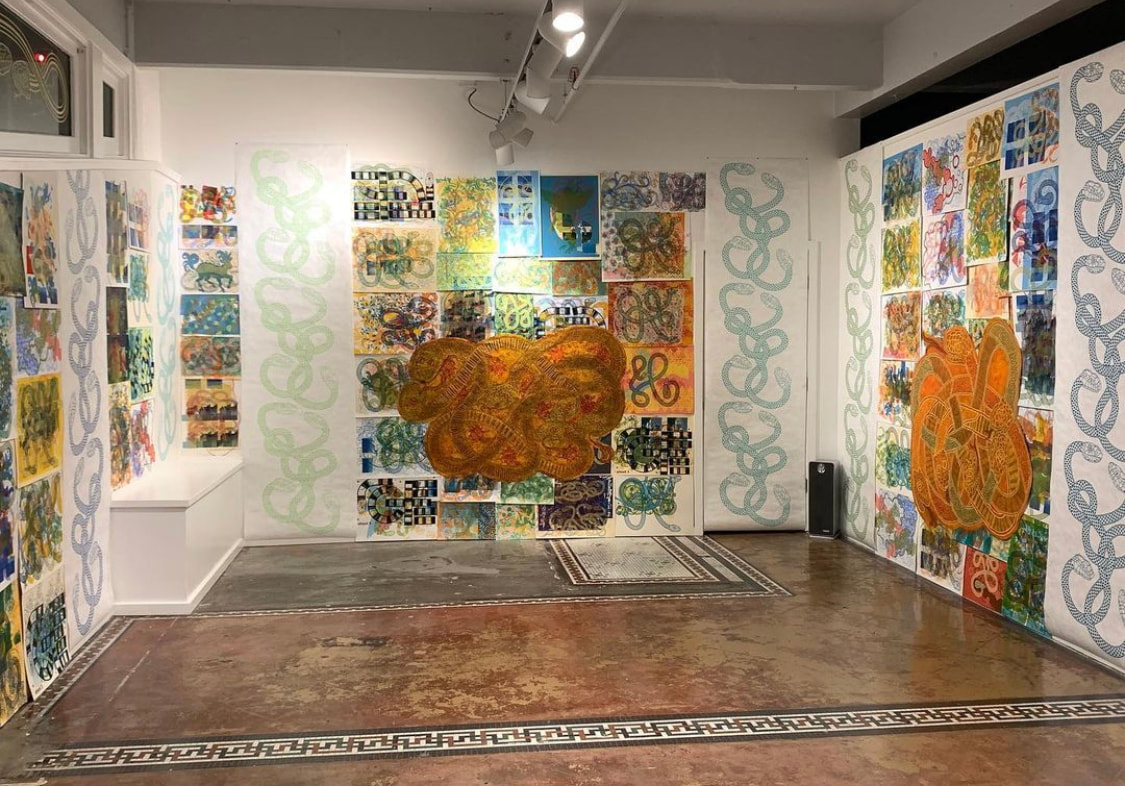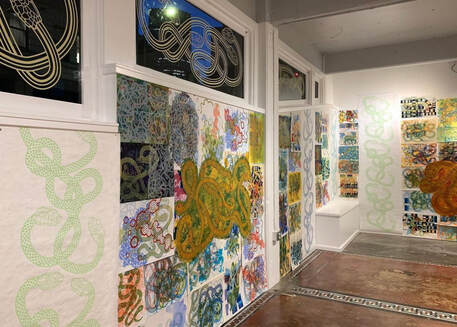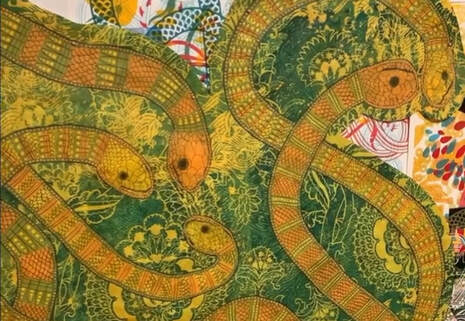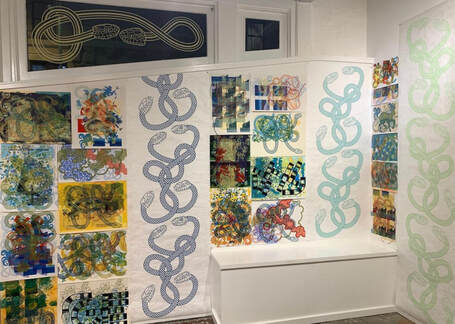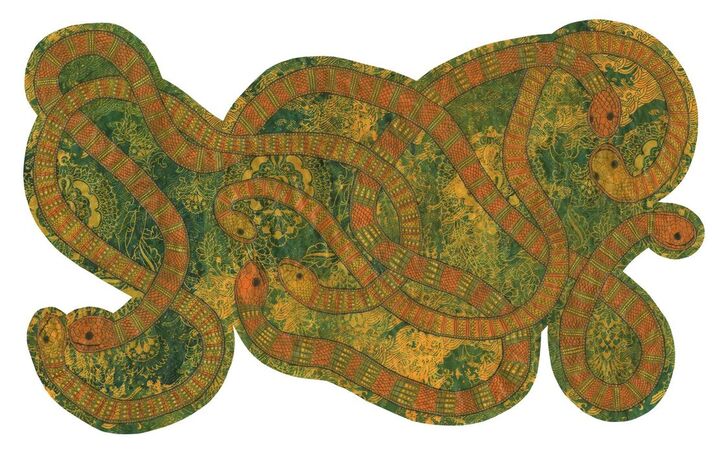 "She Sells Sea Snakes by the Sea Shore", screenprint, acrylic & graphite on cut Tyvec, 2021
"She Sells Sea Snakes by the Sea Shore", screenprint, acrylic & graphite on cut Tyvec, 2021
Tory Franklin’s installation Nest of Vipers channels her fear of snakes as she transforms METHOD into a claustrophobic den of snakes. The walls are layered with hundreds of screen-prints with colorful, labyrinth-like snake patterns, and the floor is covered with CNC routed laser cut patterns of snake parts. Franklin also uses vinyl and laser cut elements to enhance the visual experience of navigating the space.
Franklin’s narrative pieces incorporate a diverse amount of media unified by her use of pattern, print and scale. There is a constant skipping between the hand made and computer produced elements in her work. Each pass informs how the work will grow and mutate and approach the multiple (frequently in non standard ways). In the last decade she produced 10 hand printed books and over 100 screen printed flatstock editions in conjunction with her main focus on public works that utilize print technologies.
Franklin’s narrative pieces incorporate a diverse amount of media unified by her use of pattern, print and scale. There is a constant skipping between the hand made and computer produced elements in her work. Each pass informs how the work will grow and mutate and approach the multiple (frequently in non standard ways). In the last decade she produced 10 hand printed books and over 100 screen printed flatstock editions in conjunction with her main focus on public works that utilize print technologies.
ARTIST STATEMENT
For months these dual headed snakes have been writhing though my studio as I contemplated creating installations that were not Covid vectors. This show is woven from small snippets of whatever work I could get done as the world crashed around all of us. In need of a tangible
outlet I chose to focus on ways of working that I knew from past crises could soothe me. Repetitive tasks were a talisman to get through the day–printing for the physicality and familiarity of the act, a way of marking time as the calendar days blurred together.
I returned to large scale drawing systems that I developed in my twenties to help stave off panic and balance my Bipolar 2 brain. The process of building and destroying layers upon layers was a way to constrain aspects of my life–to keep me from reeling out of control. I’d spend hours
intricately patterning areas, only to cover 70% of it the next day and start the process again. Part of the process is just about showing up and spending time with the work as it grows in front of me.
All of my work contains elements of the multiple. The traditional approach to printmaking is to make exact duplications that can exist in different places. But I'm more drawn to what happens when all the copies live in the same place. Layers of print become the skeletons that my
drawings are built upon. Sometimes this manifests as the same image repeated over and over within a space, creating cacophony. For this installation I relied on screen printed monoprint techniques–the individuals share the same lineage but are not exact copies. You can find their
cousins within the crowd, but each individual piece is different in some way.
Throughout quarantine I drew and printed nests of intertwined snakes based on childhood nightmares while ruminating on how lost I get in the worlds I create. Around me constant vigilance bled into the summer of the pandemic, protests, and the political climate. The stress of
all of this churning physically manifested as my guts writhed, eating themselves like the snakes I was depicting. In the fall more stress compounded as I returned to my job at a school that had in person classes. As I watched the global cases rise, I landed in the hospital with an autoimmune flare during the lead up to the election and started a treatment that further compromised my immune system. This brought even more vigilance, the only familiar thing was my studio–danger was everywhere outside.
My work is predominantly site specific, it doesn't fully form until it's in a space. The same boxes of elements would make divergent worlds on different sites. It’s a game of call and response as the piece grows and insinuates itself into its new home. My trajectory before COVID was
increasingly interactive public works. People manipulating pulleys and cranks to make the stories come alive. All of a sudden touching anything was perilous. The floor piece Anklebiter was born of this loss, the viewer can navigate gingerly through spaces, precariously, as we have for over a year. Interacting in the in-between spaces–an amalgamation of brio train sets and the floor is lava.
Hopefully we’ll get out of this pandemic soon and I can put these snakes in a box for a decade or so, until they creep out at another point of high anxiety. But for now, they’ve made themselves a den in this space to bind and writhe for a while.
For months these dual headed snakes have been writhing though my studio as I contemplated creating installations that were not Covid vectors. This show is woven from small snippets of whatever work I could get done as the world crashed around all of us. In need of a tangible
outlet I chose to focus on ways of working that I knew from past crises could soothe me. Repetitive tasks were a talisman to get through the day–printing for the physicality and familiarity of the act, a way of marking time as the calendar days blurred together.
I returned to large scale drawing systems that I developed in my twenties to help stave off panic and balance my Bipolar 2 brain. The process of building and destroying layers upon layers was a way to constrain aspects of my life–to keep me from reeling out of control. I’d spend hours
intricately patterning areas, only to cover 70% of it the next day and start the process again. Part of the process is just about showing up and spending time with the work as it grows in front of me.
All of my work contains elements of the multiple. The traditional approach to printmaking is to make exact duplications that can exist in different places. But I'm more drawn to what happens when all the copies live in the same place. Layers of print become the skeletons that my
drawings are built upon. Sometimes this manifests as the same image repeated over and over within a space, creating cacophony. For this installation I relied on screen printed monoprint techniques–the individuals share the same lineage but are not exact copies. You can find their
cousins within the crowd, but each individual piece is different in some way.
Throughout quarantine I drew and printed nests of intertwined snakes based on childhood nightmares while ruminating on how lost I get in the worlds I create. Around me constant vigilance bled into the summer of the pandemic, protests, and the political climate. The stress of
all of this churning physically manifested as my guts writhed, eating themselves like the snakes I was depicting. In the fall more stress compounded as I returned to my job at a school that had in person classes. As I watched the global cases rise, I landed in the hospital with an autoimmune flare during the lead up to the election and started a treatment that further compromised my immune system. This brought even more vigilance, the only familiar thing was my studio–danger was everywhere outside.
My work is predominantly site specific, it doesn't fully form until it's in a space. The same boxes of elements would make divergent worlds on different sites. It’s a game of call and response as the piece grows and insinuates itself into its new home. My trajectory before COVID was
increasingly interactive public works. People manipulating pulleys and cranks to make the stories come alive. All of a sudden touching anything was perilous. The floor piece Anklebiter was born of this loss, the viewer can navigate gingerly through spaces, precariously, as we have for over a year. Interacting in the in-between spaces–an amalgamation of brio train sets and the floor is lava.
Hopefully we’ll get out of this pandemic soon and I can put these snakes in a box for a decade or so, until they creep out at another point of high anxiety. But for now, they’ve made themselves a den in this space to bind and writhe for a while.
ARTIST BIO
Tory Franklin’s narrative pieces incorporate a diverse amount of media unified by her use of pattern, print and scale. There is a constant skipping between the hand made and computer produced elements in her work. Each pass informs how the work will grow and mutate and approach the multiple (frequently in non standard ways). In the last decade she produced 10 hand printed books and over 100 screen printed flatstock editions in conjunction with her main focus on public works that utilize print technologies.
Tory received her BFA from Cornish College of the Arts in 2000, double majoring in mural photography and drawing. After graduating she taught herself screen printing and was eventually employed in large format commercial screen printing and high end architectural signage until moving to New Jersey to acquire a MFA focusing on print and paper installation at Mason Gross School of the Arts, Rutgers. In 2007 she relocated to Philadelphia, working in fast signage fabrication for clients like the national parks service, and used the commercial processes and industrial materials in her studio practice while creating wallpaper pieces and site specific installations and at a variety of sites in the Tri-State area. Living in a city steeped with murals as well as a history created by craftsmen and printers started to reframe the art experience she wanted to create. Employed a block away from Ben Franklin’s print shop and odd bits of trivia, like how the streets named after trees go from hardwoods to softwoods, expanded the scope of what craft can reflect as well as shape a community.
Upon returning to the Northwest in 2010 she left industry for academia to pay the bills as a print lab technician at Cornish and teaching at the VERA Project. She saved her fabricating hands to make her own work, starting with temporary works for municipalities and nonprofits such as Arts-A-Glow festival, Portland Winter Light festival, Bellwether 18, Mad Art, Storefronts Seattle, Storefronts Auburn, Sound Transit, The VERA Project, Spaceworks Tacoma and The Renton Arts Commission. In 2012 she received Artist Trust’s GAP grant to procure a vinyl plotter which has become integral to many of the materials in her work.
All of 2014 Tory worked on Four Seasons, a window residency at the tutoring center 826 Seattle, which changed biweekly focusing on four global tales themed to the seasons throughout the year. For this body of work she received a City Artists project grant from the Seattle Office of Arts & Culture and a 4Culture project grant to learn and produce laser cut and CNC routed puppets. Tory has since acquired both these technologies to use in her home studio.
In 2015 she created her first permanent window piece with her sister, Eroyn Franklin, for Harborview Medical Center. They covered a skybridge with digitally printed clear vinyl to create a stained glass like glow which led into other light based projects. Eroyn and Tory are currently working on several pieces for Sound Transit’s Star Lake light rail station in Kent that will open at the end of 2024. The duo is creating patterns based on indigenous edible plants that will be printed in ceramic ink on a station length windscreen and a backlit laser cut metal tunnel. They also created a Formliner cast cement bas relief mural for a retaining wall for the station that will spread the length of a baseball field for Mark Twain Elementary that is currently at the fabricators and will start being cast this summer.
This project was supported by MadArt's Artist 2020 Relief Program.
For more information: https://www.folktalefabrications.com/nest-of-vipers and on Instagram: toryfranklin_printwww.folktalefabrications.com/nest-of-vipers
Tory Franklin’s narrative pieces incorporate a diverse amount of media unified by her use of pattern, print and scale. There is a constant skipping between the hand made and computer produced elements in her work. Each pass informs how the work will grow and mutate and approach the multiple (frequently in non standard ways). In the last decade she produced 10 hand printed books and over 100 screen printed flatstock editions in conjunction with her main focus on public works that utilize print technologies.
Tory received her BFA from Cornish College of the Arts in 2000, double majoring in mural photography and drawing. After graduating she taught herself screen printing and was eventually employed in large format commercial screen printing and high end architectural signage until moving to New Jersey to acquire a MFA focusing on print and paper installation at Mason Gross School of the Arts, Rutgers. In 2007 she relocated to Philadelphia, working in fast signage fabrication for clients like the national parks service, and used the commercial processes and industrial materials in her studio practice while creating wallpaper pieces and site specific installations and at a variety of sites in the Tri-State area. Living in a city steeped with murals as well as a history created by craftsmen and printers started to reframe the art experience she wanted to create. Employed a block away from Ben Franklin’s print shop and odd bits of trivia, like how the streets named after trees go from hardwoods to softwoods, expanded the scope of what craft can reflect as well as shape a community.
Upon returning to the Northwest in 2010 she left industry for academia to pay the bills as a print lab technician at Cornish and teaching at the VERA Project. She saved her fabricating hands to make her own work, starting with temporary works for municipalities and nonprofits such as Arts-A-Glow festival, Portland Winter Light festival, Bellwether 18, Mad Art, Storefronts Seattle, Storefronts Auburn, Sound Transit, The VERA Project, Spaceworks Tacoma and The Renton Arts Commission. In 2012 she received Artist Trust’s GAP grant to procure a vinyl plotter which has become integral to many of the materials in her work.
All of 2014 Tory worked on Four Seasons, a window residency at the tutoring center 826 Seattle, which changed biweekly focusing on four global tales themed to the seasons throughout the year. For this body of work she received a City Artists project grant from the Seattle Office of Arts & Culture and a 4Culture project grant to learn and produce laser cut and CNC routed puppets. Tory has since acquired both these technologies to use in her home studio.
In 2015 she created her first permanent window piece with her sister, Eroyn Franklin, for Harborview Medical Center. They covered a skybridge with digitally printed clear vinyl to create a stained glass like glow which led into other light based projects. Eroyn and Tory are currently working on several pieces for Sound Transit’s Star Lake light rail station in Kent that will open at the end of 2024. The duo is creating patterns based on indigenous edible plants that will be printed in ceramic ink on a station length windscreen and a backlit laser cut metal tunnel. They also created a Formliner cast cement bas relief mural for a retaining wall for the station that will spread the length of a baseball field for Mark Twain Elementary that is currently at the fabricators and will start being cast this summer.
This project was supported by MadArt's Artist 2020 Relief Program.
For more information: https://www.folktalefabrications.com/nest-of-vipers and on Instagram: toryfranklin_printwww.folktalefabrications.com/nest-of-vipers

